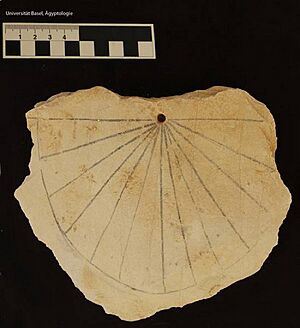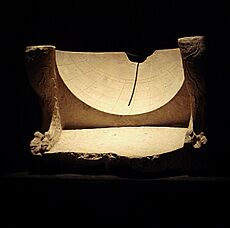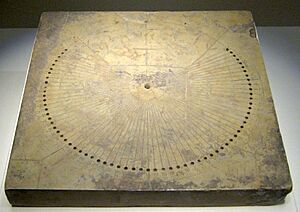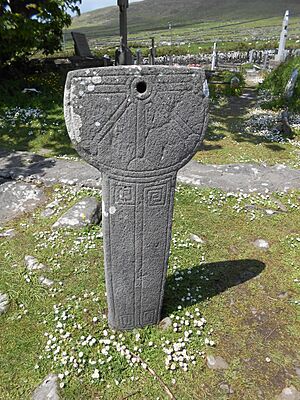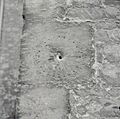History of sundials facts for kids
A sundial is a cool tool that tells time using the sun's shadow. As the Earth spins, the sun seems to move across the sky. This movement creates a shadow that changes position on a special marked surface. Both the shadow's direction and its height can be used to measure time. Sundials were invented by many different cultures around the world. They became more accurate as people learned more about the sun and shadows.
Contents
How Sundials Work
Sundials show the local time for their specific spot. Before modern clocks and railways, sundials were the main way people told time. They were important for governments and businesses. Even after clocks were invented, sundials were still useful. Early clocks weren't very accurate, so people used sundials to reset them. Sundials also helped sailors figure out their longitude (their east-west position). Today, sundials are mostly beautiful decorations. But they are still a fun way to connect with ancient science!
A Look Back: Sundial History
Early Sundials
The oldest known sundials were found in Ancient Egypt and ancient Babylonian astronomy. They date back to about 1500 BC. People probably used shadows to tell time even earlier than that. The Old Testament mentions a sundial, the "dial of Ahaz," around 700 BC. This might be the earliest written record of a sundial. Sundials were also used in China and the ancient African kingdom of Kush.
The ancient Greeks really improved sundial design. Anaximander is thought to have brought sundials to Greece around 560 BC. The Greeks were good at geometry, which helped them understand how shadows move. This led to more advanced sundials. The mathematician Theodosius of Bithynia even invented a sundial that could be used anywhere on Earth!
The Romans later adopted Greek sundials. The first record of a sundial in Rome is from 293 BC. The Roman writer Vitruvius listed many types of sundials in his book De Architectura. These sundials mostly differed in the shape of the surface where the shadow fell. One famous Roman sundial was the Solarium Augusti, built around 10 BC. It was a huge obelisk that cast a shadow on a flat surface.
Sundials in the Middle Ages
After the Greeks and Romans, astronomers in Islamic countries and later in Europe continued to develop sundials. In England, the Venerable Bede taught people how to tell time using shadow lengths. He also encouraged the use of special sundials to mark prayer times. The oldest sundial in England is from the 7th or 8th century.
Early sundials often showed "unequal hours." This meant that an hour was shorter in winter and longer in summer. Later, sundials were made with a gnomon (the part that casts the shadow) pointing towards the North Star. These sundials could show "equal hours," which are the same length all year round. This type of sundial was used in Europe by at least 1446.
In the 1500s, Italian astronomer Giovanni Padovani wrote a book about making sundials. Later, Giuseppe Biancani also wrote about how to build perfect sundials. In the 18th and 19th centuries, many sundials were made in the villages around Briançon, France.
Modern Sundials
Even today, sundials are still being designed! The Taipei 101 skyscraper in Taiwan, which opened in 2004, is over 500 meters tall. The park next to it uses the tower itself as the gnomon for a giant horizontal sundial. This shows how ancient ideas can still inspire modern designs.
Gallery
-
The Giant Sundial of Jantar Mantar in Jaipur, India, is 27 meters tall! Its shadow moves 1 millimeter every second. 26°55′29″N 75°49′29″E / 26.9247°N 75.8248°E
- Modern
-
A modern sundial in Gyeongbok Palace in Seoul, South Korea. 37°34′43″N 126°58′38″E / 37.578611°N 126.977222°E The tip of the pointer shows the time of year.
See also
 In Spanish: Historia de la gnomónica para niños
In Spanish: Historia de la gnomónica para niños
- Foucault pendulum
- Horology (the study of time and clocks)
- Scottish sundial
- Tide dial (early sundials that showed prayer times)
- Wilanów Palace Sundial


